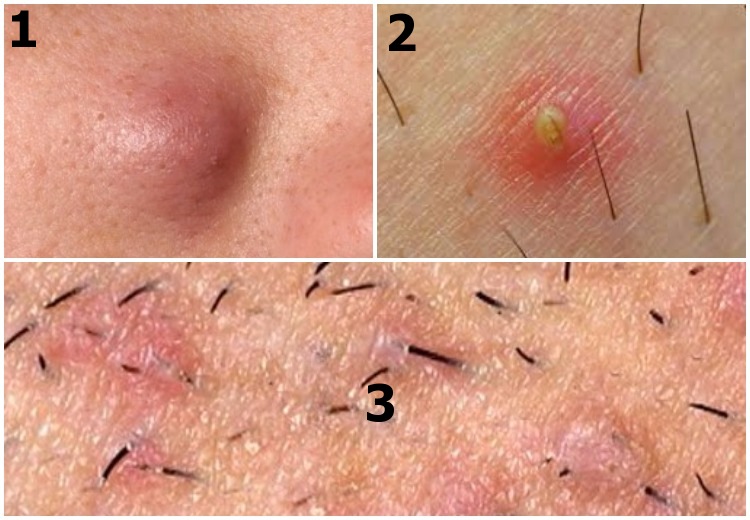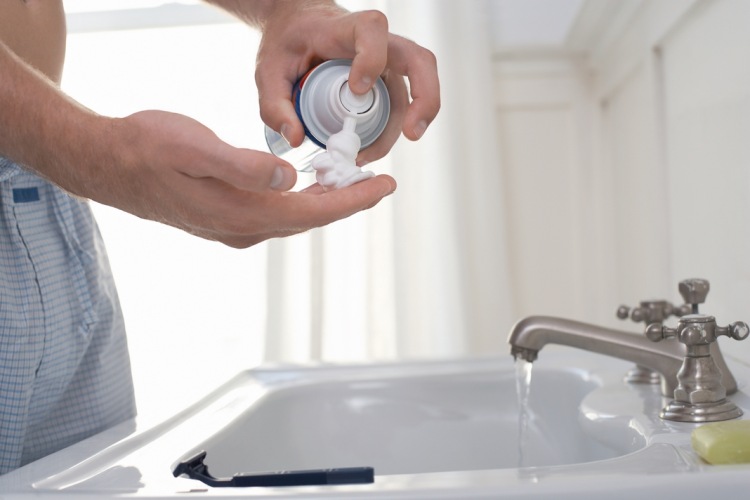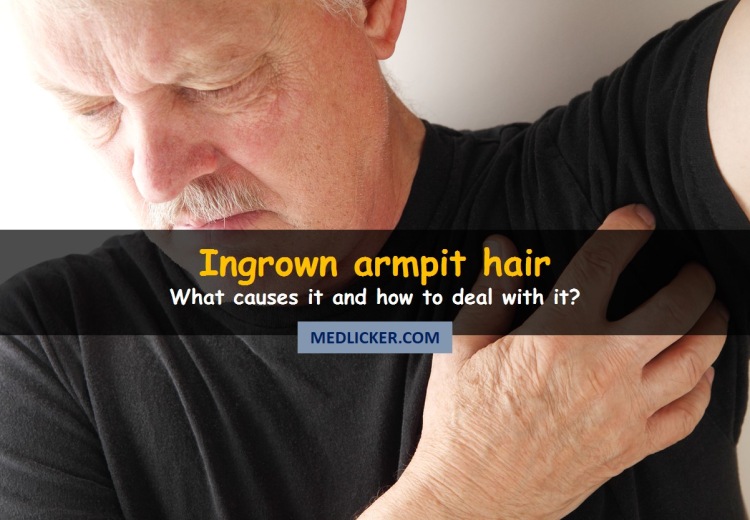Ingrown Armpit Hair: Overview of Causes, Treatment and Prevention!
An ingrown underarm hair may cause you a lot of problems. It is usually associated with armpit pain, irritation, swelling and even deep cysts or boils. What is more, it can sometimes be difficult to tell an ingrown armpit hair from an enlarged lymph node.
Here is a detailed post explaining the causes, treatment, and prevention of ingrown underarm hair.
Both evidence-based approach and natural home remedies are discussed in this article.
What is an ingrown armpit hair and how does it look like?
As you probably know, hairs grow not only on our scalp (head) but also in other areas of the body, including armpits, pubic area, chest, and limbs. Hairs grow from structures called hair follicles.
As your underarm is a place on your body, where most hair grows, ingrown armpit hairs are very common.
The medical term for ingrown hair is folliculitis so you may refer to armpit ingrown hair as underarm folliculitis.
Having an ingrown hair means that a part of your hair, which typically grows out of the skin, gets either "trapped" in the skin and or is bent down and starts to grow in the wrong direction, which may cause problems like pain, itching and underarm discomfort (1).
Ingrown armpit hairs may have various appearances. Sometimes they just look like small red pimples with no discharge, while other times they may be filled with yellow pus and blood or cause large bumps or lumps under the skin can be "hidden" under the skin.
If more than one underarm hair is affected large areas of your axilla may become red and swollen and you may have lots of pimples, lumps, boils, and deep cutaneous cysts spread all over your armpits.
Another extremely rare cause of ingrown armpit hair may be a condition called Cutaneous pili migrans, in which a tiny hair fragment gets trapped under the skin, starts moving and causes inflammation. This disorder is very painful but luckily it is easy to cure by a surgery, in which the hair fragment is removed (2).
Here is a picture of the three most common presentations of ingrown underarm hair.

Underarm ingrown hair - different presentations: (1) Deep cyst or boil - (2) Pus filled pimple - (3) Folliculitis affecting large area
What causes ingrown underarm hair?
Some people are more prone to get ingrown armpit hair than others. Usually, if your hair is curly or coarse, you are more likely to get ingrown underarm hair (3).
Curly hairs are more likely to bend down and grow in the wrong direction or get stuck in the skin, which causes folliculitis.
Ingrown underarm hair is commonly associated with axilla hair shaving.
Having hairy armpits is socially awkward because it is frequently related to strong underarm odor and nobody wants to smell bad.
Therefore, many people shave their armpits regularly, which may irritate the skin, cause razor burns and ingrown underarm hair.
There is also a higher risk of ingrown armpit hair if you had surgery in the axilla or after application of Botox injections.
Both procedures disrupt the integrity of skin tissue, which may increase the risk of getting an ingrown armpit hair.
And last but not least, this problem can be associated with some rare medical conditions, such as cutaneous pili migrans.
How to get rid of ingrown armpit hair?
We suggest using proven (evidence-based) methods for treatment of ingrown armpit hair (1).
If the problem does not go away on its own (which is often the case) you should go and see your doctor to avoid a risk of a severe infection, which may spread out to other tissues and organs and can even be life-threatening.
An evidence-based approach to the treatment of ingrown armpit hair involves both surgical methods and pharmaceuticals.
Surgical methods
A small surgery is popular treatment method for ingrown armpit hair. Your doctor will cut your skin using some sterile tools (scalpel, needle, laser, etc.) and remove the ingrown hair.
In more severe cases (ingrown hair cysts, boils, cutaneous pili migrans) the whole area is cleaned, and antibiotics are applied topically to the wound to prevent acute infection.
Other surgical ingrown armpit hair methods include cryotherapy (cryoablation), electrolysis and argon laser therapy
Pharmaceuticals (medical drugs)
Medications used in the treatment of underarm ingrown hairs include antiseptics, antibiotics, corticosteroids, and retinoids.
Antiseptics and antibiotics
We use antiseptics and antibiotics to kill the germs around ingrown hairs. This prevents spreading of infection into deeper layers.
These medical drugs can be used topically or orally. Just apply an antiseptic jelly, cream or liquid to the area, where you have an ingrown hair. Most of these medications are available at your local pharmacy as over the counter remedies. Ask your pharmacist for advice or look for products containing hydrogen peroxide, iodine, isopropanol, etc.
Usually, topical application is sufficient in skin infections associated with ingrown armpit hair.
Just apply an antiseptic jelly, cream or liquid to the area, where you have an ingrown hair.
Most of these medications are available at your local pharmacy as over the counter remedies. Ask your pharmacist for advice or look for products containing hydrogen peroxide, iodine, isopropanol, etc.
If a severe infection accompanies your armpit ingrown hair, you may need to get a prescription from your physician for oral antibiotics.
Commonly used antibiotics for skin infections associated with an ingrown hair are cephalosporins, penicillins, linezolid, methicillin, vancomycin, etc. (4, 5).
Steroid medicines
Corticosteroids (e.g. steroid medicine) may help you ease skin swelling, itching, and irritation (6).
Steroid medications may be applied topically (as creams, lotions, and jelly) or taken orally (in the case of severe systemic infections).
On the other hand, corticosteroids must not be used without prior prescription of your doctor, and they are contraindicated in untreated acute bacterial infections (because they slow down the immune response and may make things worse).
Retinoids
Treatment of ingrown armpit hair also include medicines, which do not treat inflammation or infection but may still be helpful.
Retinoids (Renova, Retin-A and other derivatives of vitamin A) are used as anti-aging topical agents, which remove dead cells and reduce wrinkles and pigment changes associated with ingrown armpit hair (e.g. postinflammatory hyperpigmentation) (7, 8).
Retinoids must not be used in pregnancy as they may cause serious congenital defects in your baby. If you are pregnant and need to get rid of an ingrown underarm hair, see your doctor to get proper treatment without harming your baby.
Natural (home) remedies
There are also many natural home remedies for ingrown underarm hair. The most popular ones are described below. Ingrown hair in your underarm often goes away without any treatment. Here are some more evidence-based tips on how to deal with ingrown armpit hair.
However, you should not put undue reliance on any of these natural remedies as they are not backed up by evidence-based medical studies. They are based on anecdotal evidence and may or may not help you get rid of ingrown armpit hair.
Before you take or apply any of the natural remedies below, always get a prior consent of your physician!
Otherwise, you may worsen the problem.
So, let us dive in some of the most popular natural remedies for ingrown armpit hair.
Stop irritating your skin
As proper healing of ingrown hair takes some time it is a good idea to stop irritating your skin until the problem is cleared.
This means that you have to say no to shaving, waxing, hair plucking, scratching or picking the ingrown hair until the skin wound heals.
If you fail to follow this advice, it increases the risk of skin infection (e.g. folliculitis, furuncles, carbuncles and even deep tissue infections, which may be life-threatening) and scar formation.
Warm compress
Applying a hot compress on affected area may help you get rid of ingrown armpit hair.
You may make a warm compress at home using a tube sock. Fill it up with some uncooked rice, oats or beans until it is about 1/2 full.
Then add some herbs, such as lavender, chamomile, peppermint, cinnamon, etc. to get a pleasantly smelling compress.
Close the open end of the sock with a cord. Microwave the compress for 30 to 40 seconds until its temperature reaches 25 - 35°C.
Wrap the sock in a thin towel (or piece of fabric), which will serve as a barrier between your skin and the compress.
Then place the compress under your shoulder, press your arm against your chest and hold for 10 minutes.
If the compress feels too hot, remove it immediately to prevent blisters and burns and wait until it cools down to a bearable temperature before applying it again.
You may also buy a hot compress at your local pharmacy.
Tea tree oil
People have been using tea tree oil for its antimicrobial and antibacterial properties for ages.
While no studies confirmed the efficacy of tea tree oil in the treatment of ingrown underarm hair, some people claim, that it is an effective home remedy for skin problems, including ingrown hair.
Here is how to make it.
Mix 1 part of tea tree oil in 5 parts of water and apply it on affected area with a clean cotton ball. Wash your skin with lukewarm water after 10 minutes.
Baking soda
Baking soda may ease skin inflammation associated with ingrown armpit hair.
It also adjusts the pH (e.g. acidity) of the skin barrier, preventing further spread of infection.
Here is how to make and use this remedy.
Add one tablespoon of baking soda into 1 cup (235 ml) of water.
Stir well and apply to your skin using a clean cotton ball. Rinse with cold water after 10 minutes.
Remove dead skin cells
Regular removal of dead skin cells (exfoliation) may also help you deal with ingrown underarm hair.
However, you should exfoliate when you do not have ingrown armpit hair as exfoliation may irritate the skin and result in inflammation or infection.
Exfoliate regularly to prevent getting ingrown underarm hair.
There are many products you may use to remove dead skin cells, including salicylic acids, benzoyl peroxide creams, non-greasy moisturizers, etc.
Go to your local pharmacy to get advice on exfoliating creams available on the market and suitable for your skin.
You may also make an exfoliating sugar scrub at home.
Mix 1 tablespoon of brown sugar with three tablespoons of olive oil or raw honey.
Stir well.
Gently and in a circular motion, rub the paste in the skin under your arms.
Rinse the skin with lukewarm water after 10 minutes.
Aloe vera
Aloe vera gel has many healing powers. It is a proven natural remedy for inflammation and itchiness.
Here is how to use aloe vera in treatment of ingrown armpit hair.
Extract some fresh gel from aloe vera leaves.
Apply the gel on ingrown hair.
Wait for half an hour before rinsing the skin with lukewarm water.
Apple cider vinegar
Apple cider vinegar is a traditional remedy for various skin problems. Its anti-inflammatory, anti-microbial and anti-fungal properties may help you get rid of inflammation and infection associated with ingrown underarm hair.
Here is how to make the remedy.

Apple cider vinegar may be used in treatment of ingrown underarm hair
Mix 1 part of apple cider vinegar in 5 parts of water.
Apply the remedy to ingrown hair pimple and the surrounding area.
Let the skin absorb the vinegar for 10 minutes and rinse the area with lukewarm water.
Use this remedy two times a day.
Cucumber slices
Cucumbers have moisturizing properties and are commonly used in dermatology as "natural moisturizers." Thay also possesses strong anti-inflammatory effects and may be a valuable addition to your ingrown armpit hair remedy arsenal.
Here is how to proceed.
Wash a medium-sized cucumber and cut it into slices.
Refrigerate the slices for 45 minutes.
Gently massage the ingrown hair area with chilled cucumber slices.
Repeat two to three times a day for the best results.
How to prevent ingrown underarm hair?
Do you know the saying "An ounce of prevention is worth a pound of cure"?
Even doctors say that prevention is much better more effective than any treatment.
Here are some tips on prevention of ingrown armpit hair (3).
The primary cause of ingrown armpit hair is shaving, waxing, tweezing and similar hair removing procedures.
Avoiding these techniques may help you lower the risk of ingrown armpit hair. You may use alternative hair removal methods, such as laser therapy.
If you must shave your underarm hair, follow these tips.
Moisture your skin with lukewarm water before shaving. Then apply mild shaving cream or gel and allow it to act and soften your hair for 2 - 3 minutes.
Make sure your razor is sharp. If possible use a new blade every time, you shave your armpits.
Shave in the direction of hair growth and wash the blade after each stroke.
Wash your shaved skin with lukewarm water, dry with a towel and apply your after-shave lotion.
Do not shave too closely and do not pull your skin taut. The shorter you cut your armpit hair, the higher the risk that the hair breaks back through your skin and grows in.
Do not tweeze ingrown underarm hair as it may result in infection, particularly if you disrupt deeper layers of the skin.
Use an electric razor if you want to get a "uniform" cut and prevent close shaving.

A sharp razor and shaving foam will help you prevent ingrown armpit hair
When using chemical hair removal products (e.g. depilatory creams), always test them on a small skin area at first as they may irritate and even burn your skin.
Use prescription products such as eflornithine (Vaniqa) to decrease the speed of hair growth.
Avoid skin products containing alcohol as alcohol may irritate your skin.
Calm your razor burns with aloe vera or cortisone creams immediately. Then do not remove your armpit hair for a few days to give your skin a break.
When to see a doctor?
Ingrown armpit hair usually does not require any treatment and heals on its own.
You should definitely see a doctor if:
- the problem persists for longer than a week.
- the ingrown underarm hair is associated with fever, discharge of pus or blood from the wound.
- you have unusual (or abnormal) hair growth, e.g. your hairs grow either too fast or too slow.
- you have an armpit lump, which is swollen, hard and non-movable.
- you want to try any home remedies described in this article and are not sure whether they are right for you or not.
To put it in a nutshell just go and see a doctor anytime you need a health-related advice.
How to tell an ingrown armpit hair from a swollen lymph node?
Sometimes, ingrown armpit hair may be confused with a swollen lymph node. While you should always see a doctor to tell an ingrown underarm hair from a swollen lymph node, here are the main differences between the two presentations:
- Ingrown hair lump is usually painful when touched while you may not feel any pain when touching a swollen lymph node.
- Ingrown hair lump is usually tender (e.g. soft when touched) while a swollen lymph node feels hard and does not move when pressed.
- Ingrown hair lump is sometimes accompanied with pus or bloody discharge, while a swollen lymph node is usually discharge free.
It is critical to understand the difference between a swollen lymph node and an ingrown underarm hair as swollen lymph nodes might be a sign of cancer or other disorders.
Things to remember
Ingrown underarm hair is usually caused by incorrect or improper shaving technique.
The condition often treats on its own, but you should see a doctor if the problem persists.
Treatment options for ingrown underarm hair include surgical methods (cryotherapy, lasers, general surgery, etc.), pharmaceuticals (antibiotics, corticosteroids, retinol, aspirin, etc.) and home remedies, such as apple cider vinegar, baking soda or aloe vera.
You should get a prior consent of your physician before taking or using any natural remedies for ingrown armpit hair as these treatments are not backed up by scientific studies.
To prevent ingrown armpit hairs, you need to use a correct shaving technique, opt for less invasive ones, such as laser hair removal and use quality skin products to soothe irritation after shaving, waxing or any other hair removal procedures.
| Written by: | Michal Vilímovský (EN) |
|---|---|
| Education: | Physician |
| Article resources: | See numbered references in the article. |
| Image resources: | Stockphotosecrets.com |
| Published: | June 26, 2017 at 6:10 PM |
| Next scheduled update: | June 26, 2019 at 6:10 PM |
Get more articles like this in your inbox
Sign up for our daily mail and get the best evidence based health, nutrition and beauty articles on the web.


Ache in left arm that you should not ignore
Alkaline water dangers: why you should not drink it
How to Avoid Sleepiness While Studying?
23 Foods That Increase Leptin Sensitivity
Low dopamine (e.g. dopamine deficiency): causes, symptoms, diagnosis and treatment options
Swollen taste buds: the ultimate guide to causes, symptoms and treatment
Thin endometrial lining: causes, symptoms, diagnosis and treatment
Pimples inside nose: the complete guide
Holes in tonsils: definition, symptoms, treatment and prevention
How to deal with an ingrown hair cyst
Allegra vs. Zyrtec vs. Claritin
Allergy to penicillin and alternative antibiotics
How to get rid of phlegm (excessive mucus) in throat? Detailed guide to medical and home remedies, symptoms and causes
What causes stomach ache after meals?
Liver blood test results explained